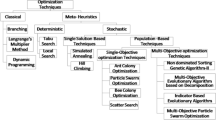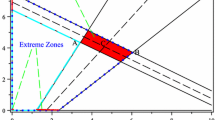Abstract
A method of solving the 0–1 knapsack problem which derives from the “shrinking boundary method” is described and compared to other methods through extensive computational experimentation.
Similar content being viewed by others
References
E. Balas, “Discrete programming by the filter method”,Operations Research 15 (1967) 915–957.
G.H. Bradley, “Transformation of integer programs to Knapsack problems”, 38th Nat. Meeting of the ORSA, Detroit, October 1970.
R. Faure, “Quelques aspects de la programmation linéaire en nombres entiers”, Extrait des Actes du Colloque de Calcul Numérique et Mathématiques appliquées (Lille, 1964).
D. Fayard and G. Plateau, “Contribution à la résolution du problème du Knapsack”, Thèse de Doctorat de Spécialité, Université des Sciences et Techniques de Lille I (September, 1971).
D. Fayard and G. Plateau, “Résolution du problème du Knapsack en variables bivalentes. Comparaison de méthodes”,Bulletin de la Direction des Etudes et Recherches E.D.F., Sér. C (1) (1972) 5–42.
D. Fayard and G. Plateau, “Résolution d'un problème d'affectation”,Bulletin de la Direction des Etudes et Recherches E.D.F. Sér. C (1) (1973) 83–108.
D. Fayard and G. Plateau, “Programmation linéaire bivalente — un algorithme efficace et applications”,Cahiers du Centre d'Etudes de Recherche Opérationelle 16 (4) (1974).
A.M. Geoffrion, “Integer programming by implicit enumeration and Balas' method”,SIAM Review 9 (2) (1967) 178–190.
A.M. Geoffrion, “An improved implicit enumeration approach for integer programming”,Operations Research 17 (1969) 437–454.
F. Glover, “A multiphase-dual algorithm for the zero–one integer programming problem”,Operations Research 13 (1965) 879–919.
F. Glover, “Surrogate constraints”,Operations Research 16 (4) (1968) 741–749.
H. Greenberg and R.L. Hegerich, “A branch search algorithm for the Knapsack problem”,Management Science 16 (5) (1970) 327–332.
R.M. Saunders and R. Schinzinger, “A shrinking boundary algorithm for discrete system models”,IEEA Transactions on Systems Science and Cybernetics, SSC-6 (2) (1970) 133–140.
C.A. Trauth and R.E. Woolsey, “Integer linear programming: a study in computational efficiency”,Management Science 15 (9) (1969) 481–493.
Author information
Authors and Affiliations
Rights and permissions
About this article
Cite this article
Fayard, D., Plateau, G. Resolution of the 0–1 knapsack problem: Comparison of methods. Mathematical Programming 8, 272–307 (1975). https://doi.org/10.1007/BF01580448
Received:
Revised:
Issue Date:
DOI: https://doi.org/10.1007/BF01580448




